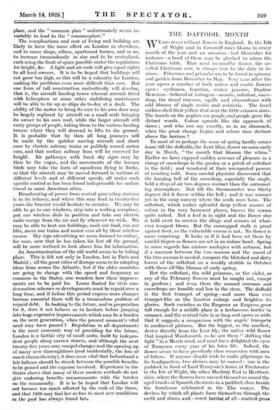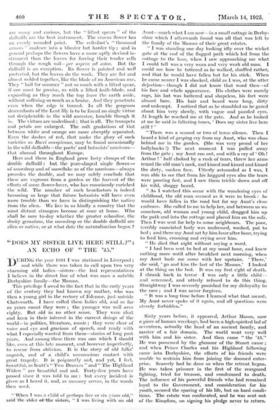THE DAFFODIL MONTH
WTE are never without. flowers in England. In the Isle of Wight and . in Cornwall- roses bloom in every month of the year and on occasion—last December for instance—a bowl of them may be plucked to adorn the Christmas table. That most un-roselike flower, the so- called Christmas rose, is always true to the date in its name. Primroses and primulas arc to be found in spinney and garden from December to 111.ay. Very soon after the year opens a number of both native and exotic flowers open : cyclamen, hepatica, winter jasmine, Daphne Mezereen—beloved of cottagers--aconite, coltsfoot, drop, the dwarf crocuses, squills and chionodoxas with odd blooms of single arabis and aubrietia. The hazel catkins shed their yellow dust over the little crimson stars. The tassels on the poplars are purple, and purple grow the distant woods. . Colour spreads like the approach of dawn ; and who can say exactly, as in an almanack, when the great change begins and colour rises distinct above the horizon ?
To most of us perhaps the sense of spring hardly comes home till the daffodils, the Lent lilies, flower on some early day in March, " the month that blooms the whins." Earlier we have enjoyed sudden accesses of pleasure in a clump of snowdrops in the garden or a patch of coltsfoot in the field ; and wondered at their unexpected powers of resisting cold. Some careful physicist discovered that the hanging bell of the snowdrop, especially the single, held a drop of air two degrees warmer than the surround ing atmosphere. Not till the thermometer was thirty degrees did it freeze within the bell ; and it was warmer yet in the snug nursery where the seeds were born. The coltsfoot, which makes splendid deep yellow masses of colour in the very barrenest places, braves the season quite naked. Not a leaf is in sight and the flower star is held erect to receive the slings and arrows of what- ever tempest blows. But the enwrapped stalk is proof against frost, as the vulnerable crocus is not. No flower is more surprising. It looks as if it had been set there by careful fingers as flowers are set in an indoor bowl. Spring in some regards has curious analogies with autumn, but if a contrast between the two seasons and the mood of the two seasons is needed, compare the blotched and_dir ty leaves of the coltsfoot on a muddy stubble in October with these elf-like blooms of early spring.
But the coltsfoot, the wild primrose, or the violet, or any of the February flowers must be sought out, except in gardens ; and even there the massed crocuses and snowdrops are humble and low in the stem. The daffodil is the first trumpet of spring—and more than ever trumpet-like as the fanciers enlarge and heighten its glories. Such varieties as the Emperor or Empress grow tall enough for a middle place in a herbaceous border in summer, and the central tube is so long and opens so wide that it suggests a comparison with the angels' trumpets in mediaeval pictures. But the biggest, as the smallest, derive directly from the Lent lily, the native wild flower that inspired Wordsworth, as he saw them " shifting the light "in a March wind, and must have delighted the eyes of Tennyson every year of his later life. Indeed, the flower seems to have peculiarly close connexion with men of letters. If anyone should wish to make pilgrimage to its headquarters, two shrines may be named : one is the paddock in front of Lord Tennyson's house at Freshwater in the Isle of Wight, the other Mackery End in Hertford- shire, where the flowers have massed themselves round the aged trunks of Spanish chestnuts in a paddock close beside the farmhouse celebrated in the Elia essays. The devices by which all plants force themselves through the earth and stones and—worst barrier of ali.---matted grass are many and curious, but the " lifted spears " of the daffodils arc the best instrument. The crocus flower has an evenly rounded point. The coltsfoot's " thousand arrows " coalesce into a blunter but harder tip ; and in general perhaps the flowers have a more 'aptly devised in- strument than the leaVes for forcing their tender cells through the rough soil—per aspera ad antra. But the daffodil is an exception. Its flower is pointed and well protected, but the leaves do the work. They are flat and almost welded together, like the blade of an American axe. They " hail far summer " not so much with a lifted spear, if one must be precise, as with a lifted knife-blade, and expanding as they reach the top force the earth aside, without suffering so much as a bruise. And they penetrate even when the edge is turned. In all the.- gorgeous descendants of the Lent lily is to be found no single virtue not decipherable in the wild ancestor, humble though it is. The virtues are underlined ; that is all. The trumpets and petals are enlarged. The soft gradations of tint between white and orange are more abruptly separated. Even the dashes of red, that make the glory of such varieties as Barri conspieaus; may be found: occasionally in the'wild daffOdils—the poets' and botanists' nareissus that abound throughout Europe.
'Here and there in England grow lusty clumps of the double daffodil ; but the pure-shaped single flower—. of snowdrop and of snowflake as of the narcissus—always precedes the double, and we may safely conclude that these are vagroms from a garden or the harvest of the efforts of some flower-lover, who has consciously enriched the wild. The number of Such benefactors is indeed becoming so large that future botanists will have even more trouble than we have in distinguishing the native from the alien. We live in so kindly a country that the Most distant strangers become at once at home. Who shalt be sure to-day whether the greater celandine, the dusky geranium, the snowdrop-or the double daffodil are alien or native, or at What date the natUralization began ?















































 Previous page
Previous page